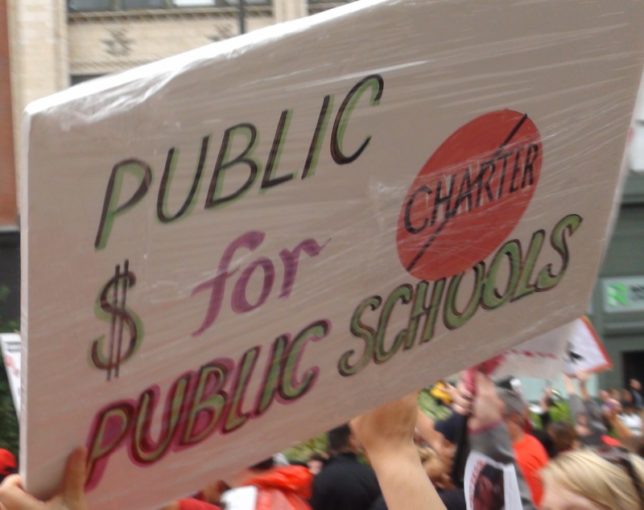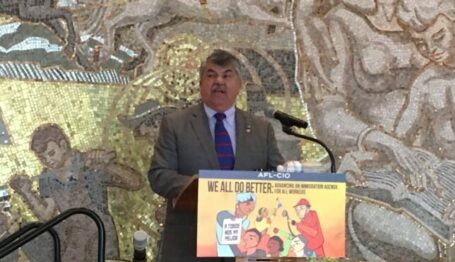Labor Watch
Los Angeles Teachers Union Continues Crusade Against School Choice


After six days of picket lines and negotiations, United Teachers Los Angeles (UTLA) finally halted their strike against the Los Angeles Unified School District (LAUSD).
The agreement terms, which were approved by UTLA’s membership, calls for a 6 percent raise for teachers and an investment of over $400 million toward reducing class sizes and adding support staff for teachers. More importantly, the terms call for union input into charter “co-location”—the placement of charter schools in traditional public school buildings. (Charter schools are government-funded public schools which operate independently of the main public school system.)
In a charter school co-location, charter schools use otherwise empty classrooms in traditional public school buildings. In Los Angeles, co-locations have been a source of controversy between the Los Angeles Unified School District (LAUSD) and UTLA for several years. While teachers at conventional district schools are required to accept representation from UTLA (and until the Janus decision last year, were required to pay dues), most charter schools are non-union. The new agreement terms between UTLA and LAUSD give the union more involvement in the selection process for co-location options.
Most importantly, in the UTLA summary of the strike negotiation terms, the following is mentioned:
The Board of Education will vote on a resolution calling on the state to establish a charter school cap and the creation of a Governor’s committee on charter schools at the next BOE meeting.
Essentially, UTLA wants to stop the rapid growth of charter schools in Los Angeles. Currently, around one in five Los Angeles public school students attend charter schools. A cap on the amount of charter schools allowed in Los Angeles, along with an oversight committee aimed at regulating charter schools, would strike a blow against educational alternatives for fustrated parents.
Twenty percent of students (and their parents) chose to attend charter schools because they are demonstrably superior to public schools, even if they share the same building.
A 2015 California Policy Center study found that Los Angeles charter schools spent 44 percent less per pupil than traditional LAUSD public schools, yet the charter school students earned higher Academic Performance Index scores ( 762 vs. 701), higher graduation rates (91.5 percent vs. 84.1 percent), and higher average SAT scores (1417 vs. 1299) than their traditional LAUSD public schools counterparts. California Policy Center’s study compared charter and traditional schools located in the same neighborhood with similar demographics, with some of the charter schools in the study having more students on free lunch programs than their traditional public-school counterparts.
Similarly, a 2014 Stanford University study found that black charter school students living in poverty in Los Angeles received 36 more days of learning in reading and 58 more days of learning in math than their LAUSD counterparts. Likewise, the study found that Hispanic charter school students living in poverty in Los Angeles received 58 additional days of learning in reading and 115 more days of learning in math than their LAUSD counterparts.
UTLA president Alex Caputo-Pearl has complained about traditional public schools in Los Angeles losing public funds to charter schools. Since public money follows students, and enrollment in traditional Los Angeles public schools has been declining with the influx of charter schools, UTLA believes that charter schools are responsible for the decline of the traditional public schools in Los Angeles.
While charter schools have certainly diverted public funds away from traditional public schools, this is not the source of UTLA’s problems.
UTLA took its first blow when their anti-charter school candidates for the LAUSD board were defeated in the 2017 school board election. In 2017, around $17 million was spent on the election race for three open school board seats for the Los Angeles Unified School District, making it one of the most expensive school board elections in U.S. history Out of the $14.7 million spent by outside groups, much of it came from either UTLA or the California Charter Schools Association.
In the race for the two most contested seats, UTLA’s independent expenditure committee spent approximately $4 million hoping to elect anti-charter school candidates Steve Zimmer and Imelda Padilla. The California Charter School Association Advocates Independent Expenditure Committee spent approximately $2.6 million to elect its pro-charter school candidates. (Overall pro-charter school groups outspent unions nearly two-to-one over the two hotly contested board seats. However, it is important to remember that the union acquired its funds through forced “agency fees” and mandatory union dues. The groups advancing school choice had to raise their funds independently from willing supporters.)
Next, UTLA took a major blow with the 2018 Janus Supreme Court decision, which overturned the ability of government sector unions, like UTLA, to demand non-union members pay fees to unions.
Topping things off, the LAUSD has vastly misallocated its resources over the past few years, which has resulted in more money tied up in educational bureaucracies rather than actually helping students learn.
According to a Reason Foundation analysis of the various financial statements and reports released by the LAUSD, student enrollment in the LAUSD declined by 9.3 percent from 2013-2017, while total salaries and benefits paid out by the school district increased by 22 percent. From 2014-2018, LA Unified schools cut back on the number of teachers they employed by 5 percent in response to declining enrollment rates, but simultaneously increased “other certified staff” (such as nurses, counselors, speech therapists, and school psychologists) by 26 percent, and increased K-12 administrators by 16 percent.
In other words, the LAUSD has increased the number of their support staff over the past four years, and the recent UTLA strike just secured hundreds of millions of dollars to spend on even more support staff—all while students flock to charter schools and the LAUSD cuts back on the number of teachers employed.
If anyone or anything is to blame for failing traditional schools in Los Angeles, it’s gross mismanagement and misallocation of resources by the LAUSD and the teachers. Perhaps, it’s this same mismanagement that has caused students in Los Angeles to flock to charter schools in recent years.



